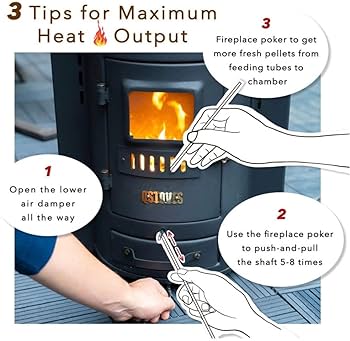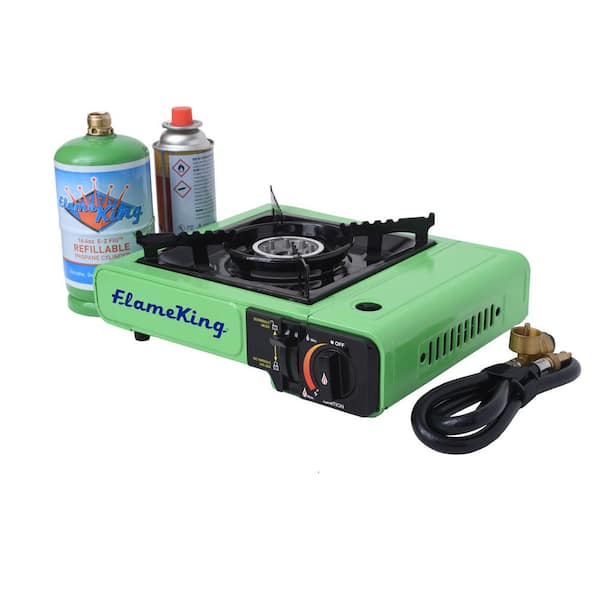To get the best heat from a multi fuel stove, use well-seasoned wood and adjust air dampers accordingly. It’s important to properly maintain and clean the stove for optimal performance.
Multi fuel stoves can efficiently heat your home while also adding a cozy ambiance. By following some key tips and tricks, you can maximize the heat output of your stove. From selecting the right fuel to managing airflow, these simple steps can make a significant difference in the warmth and comfort of your space.
In this guide, we will explore the best practices for getting the most out of your multi fuel stove and creating a welcoming atmosphere in your home. By implementing these strategies, you can enjoy efficient and effective heating throughout the colder months.


Credit: www.americastestkitchen.com
Choosing The Right Fuel
Choosing the right fuel for your multi-fuel stove is crucial to getting the best heat output and efficiency. By selecting the appropriate fuel, you can optimize the performance of your stove and ensure a cozy and warm atmosphere in your home.
Quality Matters
Using high-quality fuel can significantly impact the heat production and cleanliness of your stove. Opt for well-seasoned firewood or manufactured smokeless fuels to minimize smoke and maximize heat output.
Understanding Different Fuel Types
Different fuel types have varying combustion properties. Familiarize yourself with the characteristics of wood, coal, and eco-friendly alternatives to choose the most suitable option for your stove.

Credit: www.amazon.com
Optimizing Airflow
A well-functioning multi-fuel stove relies on optimized airflow to generate efficient and consistent heat output. By properly managing air vents and utilizing the secondary combustion process, you can maximize the performance of your stove.
Managing Air Vents
- Adjust primary airflow vents according to fuel type.
- Keep vents clear to ensure proper oxygen flow.
Utilizing The Secondary Combustion
- Engage secondary combustion for extended heat production.
- Burn wood at the highest temperatures for optimal secondary combustion.
Maintaining Proper Insulation
To maximize the heat output from a multi-fuel stove, proper insulation is essential. By ensuring that the insulation around the stove and chimney is in good condition, you can improve its efficiency and retain more heat within the room. This helps to create a more comfortable and cost-effective heating environment.
Maintaining Proper Insulation When it comes to getting the best heat from a multi-fuel stove, maintaining proper insulation is crucial. Proper insulation helps to ensure that the heat produced by the stove is effectively retained within the room, maximizing its efficiency and reducing heat loss. There are a few key techniques for maintaining proper insulation that can significantly improve the performance of your multi-fuel stove. Sealing Gaps and Leaks Sealing gaps and leaks in the room where the stove is installed is essential for maintaining proper insulation. Gaps around windows, doors, and vents can allow heat to escape, reducing the overall efficiency of the stove. By sealing these gaps with caulk or weather-stripping, you can prevent heat from leaking out and cold air from entering the room, helping to maintain a consistent and comfortable temperature. Using Heat-Resistant Materials Using heat-resistant materials for the walls and flooring around the multi-fuel stove can also contribute to effective insulation. Heat-resistant materials such as brick, stone, or ceramic tiles can help to absorb and retain heat, preventing it from being lost through the walls or floor. Additionally, using a heat-resistant barrier or backing behind the stove can provide an extra layer of insulation, improving heat retention and distribution throughout the room. By employing these techniques for maintaining proper insulation, you can optimize the performance of your multi-fuel stove and ensure that you are getting the best heat possible. Taking the time to seal gaps and leaks and use heat-resistant materials will not only improve the efficiency of your stove but also contribute to a more comfortable and cozy living environment.Cleaning And Maintenance
A multi-fuel stove can be a great addition to your home, providing warmth and ambiance during those chilly winter days. To ensure that your stove continues to perform at its best, regular cleaning and maintenance are essential. By keeping your stove and chimney clean, you can maximize the heat output and efficiency of your multi-fuel stove. Here are some tips on how to get the best heat from a multi-fuel stove through cleaning and maintenance.
Removing Creosote Buildup
One of the most important aspects of cleaning and maintaining a multi-fuel stove is removing creosote buildup. Creosote is a black and sticky substance that forms inside the chimney and stove pipes when wood or coal is burned. It can reduce the efficiency of your stove and, if left unchecked, increase the risk of chimney fires.
To remove creosote buildup, follow these steps:
- Wait until the stove is cool and no longer in use.
- Wear gloves and protective eyewear.
- Use a chimney brush or a specialized creosote remover and apply it according to the manufacturer’s instructions.
- Scrub the inside of the chimney and stove pipes thoroughly to remove any creosote deposits.
- Dispose of the creosote properly and clean any residue that may be left.
Regular Chimney Inspections
In addition to removing creosote buildup, regular chimney inspections are crucial for maintaining your multi-fuel stove’s performance and safety. A chimney inspection should be done at least once a year by a certified professional, and more frequently if you use your stove extensively. During the inspection, the professional will check for any cracks or damage to the chimney, as well as any blockages that may affect the airflow.
Here are some things to consider when getting a chimney inspection:
- Hire a professional chimney sweep who is certified and experienced.
- Ask for references or read reviews to ensure the quality of their work.
- Discuss any concerns or issues you may have with the professional.
- Make sure the chimney sweep inspects both the exterior and interior of the chimney.
- Request a detailed report of the inspection findings and any recommended repairs or cleaning.
By following these tips and incorporating regular cleaning and maintenance into your routine, you can ensure that your multi-fuel stove operates at its best, providing you with optimal heat and comfort throughout the colder months.
Efficient Loading And Stoking
To optimize heat output, ensuring efficient loading and stoking of a multi-fuel stove is crucial. Properly arranging fuel and periodically adding wood or coal can enhance the stove’s performance, maximizing warmth in your living space for a cozy ambiance.
When it comes to getting the best heat from a multi fuel stove, efficient loading and stoking techniques play a crucial role. How you layer your fuel and the method you use can significantly impact the performance of your stove. In this section, we’ll explore two essential techniques for efficient loading and stoking: layering fuel correctly and applying the top-down method. By following these methods, you can maximize the heat output and enjoy a cozy and warm atmosphere in your home.
Layering Fuel Correctly
In order to achieve the best heat output from your multi fuel stove, it’s important to layer your fuel correctly. This means arranging your fuel in a way that allows for optimal air flow and combustion. When loading your stove, start with a base layer of small, dry kindling or newspaper. This layer will help to ignite the fire quickly and create a bed of hot embers.
On top of the kindling, add a layer of small-sized fuel such as twigs or small logs. These smaller pieces will catch fire easily and help to establish a steady flame. As you continue to layer your fuel, gradually increase the size of the logs or coal. Ensure that each layer is placed strategically to allow air to circulate through the fuel and promote efficient burning.
Remember to avoid overcrowding the firebox as this can restrict the airflow and hinder combustion. Creating adequate space between the fuel layers will ensure that the heat is evenly distributed and maximize the burning potential of your multi fuel stove.
Applying The Top-down Method
Another effective technique for efficient loading and stoking is the top-down method. This method involves placing the larger logs or coal on top of the smaller fuel. By starting with the larger pieces on the top, the fire will burn downwards, allowing for a longer burn time and consistent heat output.
To apply the top-down method, begin by placing a few larger logs or a generous amount of coal on the top layer of your stove. Make sure there is a sufficient gap between the fuel and the top of the stove to allow proper air circulation. Below the top layer, continue to layer smaller pieces of fuel until you reach the base layer of kindling or newspaper.
Once you have layered your fuel properly, light the fire from the top, ensuring that the flames ignite the smaller kindling and gradually work their way down to the larger fuel. This method promotes complete combustion and helps to reduce the need for constant stoking and adjusting.
By following the top-down method and layering your fuel correctly, you can achieve a longer burn time, reduce the frequency of reloading, and enjoy consistent and efficient heat from your multi fuel stove.

Credit: www.homedepot.com
Frequently Asked Questions On How To Get The Best Heat From A Multi Fuel Stove
How Can I Get The Best Heat From A Multi Fuel Stove?
To get the best heat from a multi fuel stove, make sure to use dry, seasoned wood or approved solid fuels, and maintain proper airflow by cleaning the stove regularly.
What Type Of Fuel Is Best For Multi Fuel Stoves?
The best fuel for multi fuel stoves is dry, seasoned wood or approved solid fuels like coal or smokeless fuel. Avoid using wet or green wood as it produces less heat and more smoke.
Should I Keep The Stove Door Open For More Heat?
No, keeping the stove door open will actually reduce the heat output. Keep the stove door closed to maintain proper airflow and maximize the heat generated by the stove.
Can I Adjust The Air Vents To Control The Heat Output?
Yes, multi fuel stoves usually have adjustable air vents that allow you to control the heat output. Adjust the vents according to your desired heat level, but be mindful of proper airflow for efficient burning.
How Often Should I Clean The Flue And Chimney Of My Multi Fuel Stove?
It is recommended to clean the flue and chimney of your multi fuel stove at least once a year or more frequently if you use the stove regularly. Regular cleaning ensures proper ventilation and prevents blockages that can affect heat output.
Conclusion
To maximize heat from your multi-fuel stove, follow these tips for efficient burning and heat output. With proper fuel selection and maintenance, you can ensure optimal performance. By implementing these strategies, you can create a comfortable and warm environment in your home, while also minimizing energy consumption.